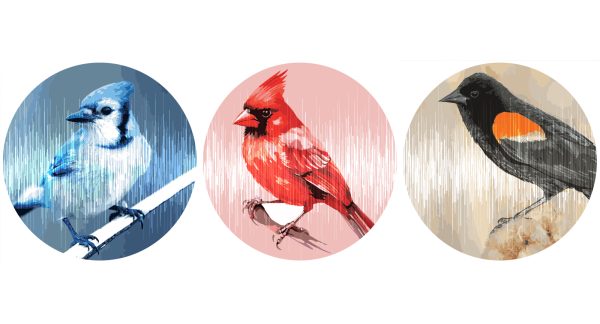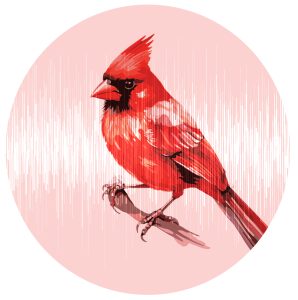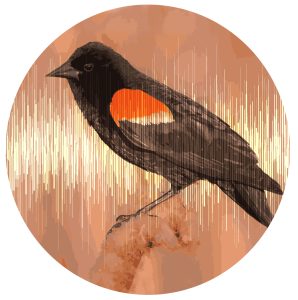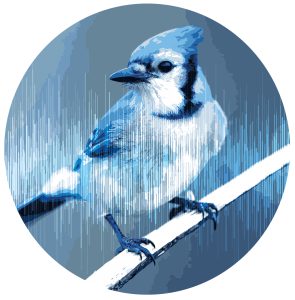This article is published in conjunction with Spacing‘s new issue (#67), which is themed around noise in the city. Click on the links of bird names to hear the relevant birdsong.
It’s ubiquitous the world over, and yet ignored by most of us. Except on the furthest reaches of the ocean and in the most extreme of biomes, the sound of birdsong underscores and comments upon every daily occurrence.
To many, it seems like a senseless chorus: an aimless and irrelevant twittering. But those who tune out the layered vocalizations of our city birds are missing out on a rich stream of conversation, warnings and even jokes.
On a Toronto summer’s day, it starts around 3AM, and I used to dread it as a teenager: that first decisive chirp in the darkness. On some nights it’s a robin; on others, a cardinal, signalling the coming of dawn, and soon to be joined by another and another, until the full chorus is underway, an orchestral greeting for the first rays of the rising sun.
As the day brightens, the earliest risers are joined by a gentle throaty hooting that might be mistaken for an owl, but it’s what one toddler of my acquaintance has dubbed The Morning Duck. Really, it’s a mourning dove, the long-tailed pigeonlike bird whose call resembles a soft, sad lament.
Next may come rapid-fire hollow bursts of tapping from woodpeckers mining the local tree trunks for insects. We have three varieties in the Toronto area. The downy woodpecker is a black-and-white fluffball who, if male, will feature a smudge of red on the back of his head. The hairy woodpecker is taller, slimmer and more robust, also with a red streak. If you spot a pileated woodpecker, you’re lucky; they’re far less common. Pileated woodpeckers are quite big, and both the males and females are crowned with an impressive bright crimson crest.
Woodpeckers aren’t merely interesting to watch; they also deliver important news, because if they favour a certain tree, they’re letting us know it’s got lots of bugs under the bark, and we should be warned that it may be in poor health.
One of my favourite sounds is the chirring call of the red-winged blackbird in summer; to me it signals the long warm days of July and August. But beware if you hear them while canoeing or strolling around marshy areas, even in local parks, because they nest among the waterside reeds, and they will fiercely dive-bomb you if they think you’re too close to their young.
These migratory birds nest in late spring and early summer – which is why I was puzzled to hear one in midwinter a few years ago. I looked around and spotted not a blackbird but a glossy iridescent grackle – a prolific imitator – playing tricks on listeners.
Blue jays are also good at impressions, and I often wonder whether they learned one of their most characteristic cries from the pulley-fed laundry lines that were once such a common backyard feature. Their high throaty caw sounds exactly like a squeaky wheel (after 0:52) when the line is tugged to advance the clothes.
Blue jays also imitate hawks very well, either to warn other birds that danger is hovering in the vicinity or to fool them. But the best notice of a raptor’s presence is the sudden silence of the smaller birds. If you notice that no birds are calling, look around, and you may well spot a hawk or an eagle circling above you; if not, look out for storm clouds, because they’ll likewise go silent when a pressure change gives warning of bad weather on the way.
Another warning cry is the piercing whistle of the kildeer. These ring-neck waders lay their eggs on sandy shores – or else in a scattering of gravel and glass pebbles on a cracked strip of pavement on any seldom-used parking lot or deserted building foundation. You can walk right up to the nest, but if you do, the guardian adult will leap between you and the babies, dragging one wing as if injured, to lure you away.
As evening descends, robins respond with their liquid chirping to the change in the light – which they also do simply if clouds darken the sky. As the sun lowers, starlings too gather together, and a crowded flock may fill a single bush with their “chattering”: a chorus or many whistlings and chucklings. The starlings, recognizable by their pale toothpick beaks, are the only birds that flock in a mesmerizing cloud, wheeling and swirling, as the sun goes down. This “murmuration” is an unforgettable sight, one that sometimes fills the air above Yonge-Dundas Square.
And, rarely, you will hear a singular sound, one that feels like it is meant for you alone. For instance, some years back, my stepdaughter was anxious about a pressing college assignment that required her to produce a newsworthy photo essay. As the deadline approached, she called me in a panic: a critical photo shoot had disappeared from her camera, and she had only a few hours left to capture some shots of birds – with sunset rapidly descending on a short winter’s afternoon.
I joined her at a nearby park, where we hoped for some sort of lucky sighting, in particular an owl. I had only once seen an owl in Toronto (that’s another story), but as my foot touched the park pathway, I waved one hand like a magic wand and said, more in hope than expectation, “I give you an owl!”
Apart from a few distant seagulls, there were no birds in that park, and we were losing the light. Then, in some scrappy undergrowth near a hidden pond, I heard a little low grunt, or a soft squawk. I paused, and heard it again. Quietly, carefully, I approached the sound, which turned out to be the voice of a splendid long-eared owl lit by the last rays of sunlight, who posed majestically for about half an hour, until it was too dark to see.
Was that owl calling me? It sure felt like it. Regardless, the birds are speaking to us all the time, and if we listen, they’ll introduce us to an entirely new dimension of urban life.





